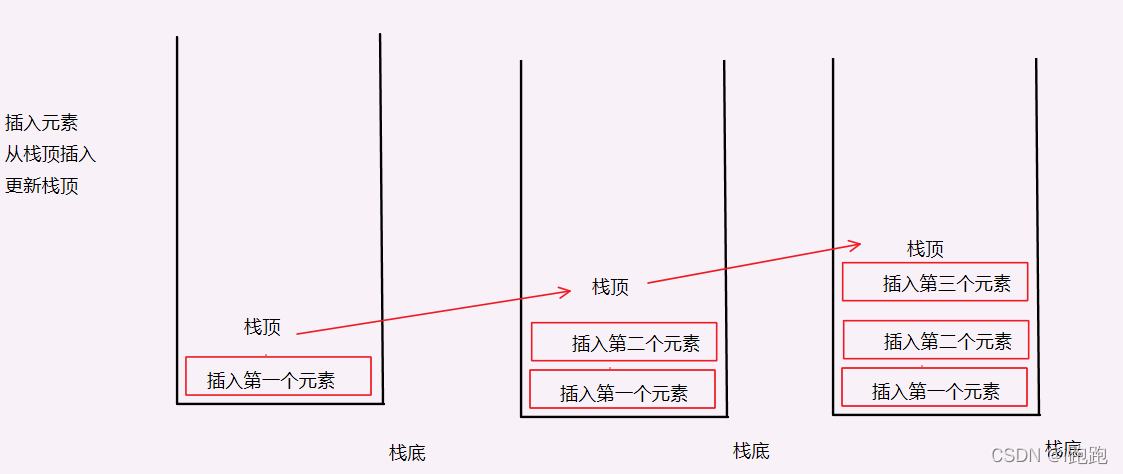栈的概念及结构
一种特殊的线性表,其只允许在固定的一端进行插入和删除元素操作。进行数据插入和删除操作的一端称为栈顶,另一端称为栈底。栈中的数据元素遵守后进先出的原则。
(封闭了一端的线性表)
压栈:栈的插入操作叫做进栈/压栈/入栈,入数据在栈顶。
出栈:栈的删除操作叫做出栈。出数据也在栈顶
图示
分析
栈是线性表,用动态数组实现更优。
需要动态开辟,需要记录有效元素个数、空间容量、还有栈顶位置。
可参考顺序表来进行理解:顺序表的实现_i跑跑的博客-CSDN博客
栈的实现
定义
起始位置,栈顶位置(用下标进行操作),容量。
typedef struct Stack
{
Datatype* a;
int top; //栈顶位置
int capacity; //容量
}ST;初始化
起始位置置空,容量为0,栈顶在下标为0的位置。
//初始化
void StackInit(ST* ps)
{
assert(ps);
ps->a = NULL;
ps->capacity = 0;
ps->top = 0;
}销毁
从起始位置开始释放掉,因为是连续开辟空间,释放起始位置即释放所有开辟的空间
容量和栈顶置0
//销毁
void StackDestory(ST* ps)
{
assert(ps);
free(ps->a);
ps->a = NULL;
ps->capacity = ps->top = 0;
}压栈
断言后,首先得检查容量是否够用,不够需要realloc空间,空间不足时若=0,则给4个Datatype类型大小的空间,若不等于0,则给定已有空间的二倍的空间大小。
空间解决后,存入数据,并更新栈顶。
//压栈
void StackPush(ST* ps, Datatype x)
{
assert(ps);
if (ps->top == ps->capacity)
{
int newcapacity = ps->capacity == 0 ? 4 : ps->capacity * 2;
ps->a = realloc(ps->a, newcapacity*sizeof(Datatype));
if (ps->a == NULL)
{
printf("realloc fail\n");
exit(-1);
}
ps->capacity = newcapacity;
}
ps->a[ps->top] = x;
ps->top++;
}出栈
要注意不仅要断言ps,还需要保证栈顶大于0,即栈内不为空。
因为开辟空间连续,不能单独释放,因此我们直接更新栈顶即可。
//出栈
void StackPop(ST* ps)
{
assert(ps);
assert(ps->top>0);
ps->top--;
}判断栈是否为空
是空返回true,非空返回false
//判断栈是否为空
bool StackEmpty(ST* ps)
{
assert(ps);
//if (ps->top > 0)
//{
// return false;
//}
//else
//{
// return true;
//}
return ps->top == 0;
}数据个数
数据个数直接为栈顶top的下标
//数据个数
int StackSize(ST* ps)
{
assert(ps);
return ps->top;
}访问栈顶元素
栈顶元素是栈顶的前一个,top-1即为栈顶元素的下标
//访问栈顶数据
Datatype StackTop(ST* ps)
{
assert(ps);
return ps->a[ps->top-1];
}头文件
#pragma once
#include <stdio.h>
#include <stdlib.h>
#include <stdbool.h>
#include <assert.h>
typedef int Datatype;
typedef struct Stack
{
Datatype* a;
int top; //栈顶位置
int capacity; //容量
}ST;
void StackInit(ST* ps);
void StackDestory(ST* ps);
void StackPush(ST* ps,Datatype x);
void StackPop(ST* ps);
//判断栈是否为空
bool StackEmpty(ST* ps);
//数据个数
int StackSize(ST* ps);
//访问栈顶数据
Datatype StackTop(ST* ps);测试文件
#include "Stack.h"
void TestStack()
{
ST st;
StackInit(&st);
StackPush(&st,1);
StackPush(&st, 2);
StackPush(&st, 3);
StackPush(&st, 4);
StackPush(&st, 5);
while (!StackEmpty(&st))
{
printf("%d ",StackTop(&st));
StackPop(&st);
}
StackDestory(&st);
}
int main()
{
TestStack();
return 0;
}

 菜鸟笔记
菜鸟笔记
